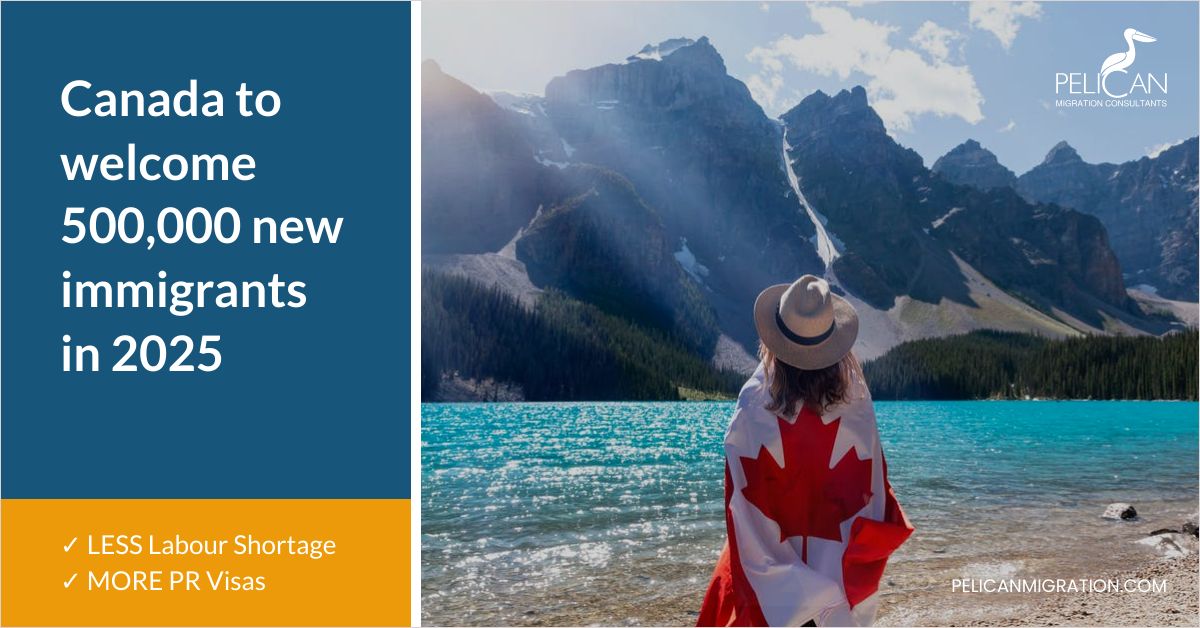
In an effort to alleviate a severe labor shortage, Canada has announced plans for a significant increase in immigration, with a target of 500,000 immigrants arriving annually by 2025. On Tuesday, the new strategy was unveiled by Immigration Minister Sean Fraser. Along with more moderate goals for family members and refugees, it places a strong emphasis on admitting more permanent residents with the necessary work skills and experience. The initiative was well received by the opposition Conservative party.
In 2023, Canada plans to take in 465,000 additional immigrants. In 2024, the goal will increase to 485,000 new immigrants. By 2025, there will be 500,000 more immigrants.
Targets for Express Entry and PNP will be raised.
The vast majority of new permanent residents enter the country through economic class programs such as those offered through the Express Entry system or through Provincial Nomination Programs (PNPs).
| Year | Express Entry (primary applicants, spouses, and dependents) | Provincial Nominee Program ( low-income immigrants) |
| 2023 | 82,880 | 105,500 |
| 2024 | 109,020 | 110,000 |
| 2035 | 114,000 | 117,500 |
Higher PGP admissions
IRCC is also tasked with reuniting families. Following economic class programs, family class sponsorship is the Immigration Levels Plan's second-largest permanent resident class. Applicants for permanent residency are sponsored for permanent residence by a spouse, partner, children, or another family member under family-class immigration schemes.
Under the Spouses, Partners, and Children program, Canada will continue to welcome approximately 80,000 new immigrants every year. The Parents and Grandparents Program's targets will climb to 28,500 in 2023, 34,000 in 2024, and 36,000 in 2025.
Refugee and humanitarian aims will be reduced.
Refugees and humanitarian immigrants are also given priority under the Immigration Levels Plan. Canada has a long history of granting asylum to people fleeing dangerous situations in their native countries.
Canada presently has high humanitarian class targets due to continuing attempts to fulfill many programs, such as accepting around 40,000 Afghan refugees. The entire refugee class target will be somewhat more than 76,000 new arrivals in 2023 and 2024, before falling to 72,750 in 2025. The humanitarian class objective is also decreasing, from roughly 16,000 in 2023 to 8,000 in 2025.
The immigration policy of Canada
In the 1980s, Canada's present immigration policy started to take shape. The government at the time did not plan as far ahead and frequently based immigration targets on the current state of the economy. Canada received fewer than 90,000 immigrants in 1984. The Canadian government, led by the Conservatives, anticipated a labor shortage in the early 1990s and upped immigration targets to 250,000 new permanent residents in just eight years.
The succeeding Liberal administration expanded on these goals but, as a result of a financial crisis, started to emphasize welcoming more immigrants from the economic class and lowering Canada's proportion of immigrants from the family and humanitarian classes. Up to the current Liberal administration entering office in 2015, Canada admitted about 260,000 immigrants yearly. Before the COVID-19 pandemic started in 2020, the targets were raised to 300,000 and then 340,000.
In 2020, it was challenging for the IRCC to process applications due to border closures and other travel restrictions. Nevertheless, Canada exceeded its goal for immigration in 2021 and admitted 405,000 more permanent residents than ever before. These goals were met thanks to the Canadian Experience Class and Provincial Nomination Programs' generous slot allocations (PNPs).
Currently, Canada is experiencing a rare situation in which there is a labor shortage and around one million open positions. Both are key determinants of the nation's rising immigration goals. The low birth rate in Canada, which is among the lowest in the world at 1.4 children per woman, has a further negative influence on the labor market. Canada's population and labor force will soon be able to grow only through immigration as a result of the slow natural increase in population (the number of births still exceeds the number of deaths each year). Additionally, Canada needs immigrants to maintain a robust tax base, which is important for its efforts to fund basic services like healthcare and education.
One of the oldest populations in the world is found in Canada. By 2030, nine million people, or roughly 25 percent of Canada's population, will be of retirement age. All areas of the economy will experience a severe labor shortage as a result of this.
The Immigration and Refugee Protection Act (IRPA), which is Canada's primary immigration statute, requires the government to publish the Immigration Levels Plan every year by November 1. The 2022–2024 immigration level plan was the second to be released in 2022, the first having been in February following the post–the most recent federal election announcement being postponed until September 20, 2021.
Would you like to migrate to Canada?
Contacting Canada Immigration Consultants is crucial if you want assistance and guidance during the protracted immigration procedure to Canada. To ensure that you perform at your best in front of the Canada immigration department, we provide customized one-on-one support. We help clients by evaluating their chances of getting a visa, helping them get ready for and get feedback from VISA interviews, and creating a custom immigration strategic plan for each client.
We give our applicants a good probability of success because of our expedited application procedure. Because all of our immigration cases are handled by qualified and experienced immigration consultants, you can count on us. In addition to being licensed and having extensive knowledge of the Canadian immigration process, our specialists So, if you're ready to take the next step, why not contact us right away to arrange a private immigration consultation?


